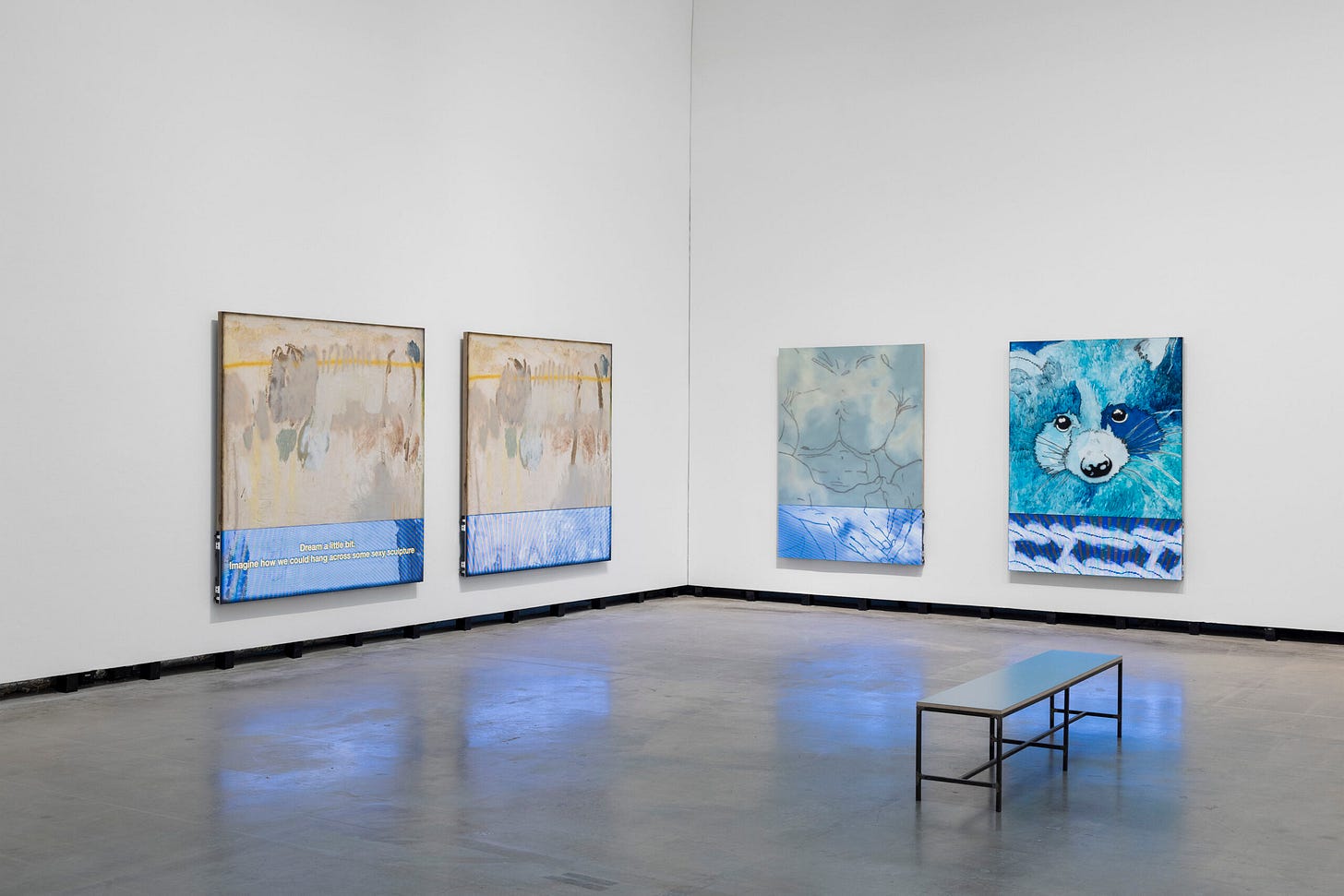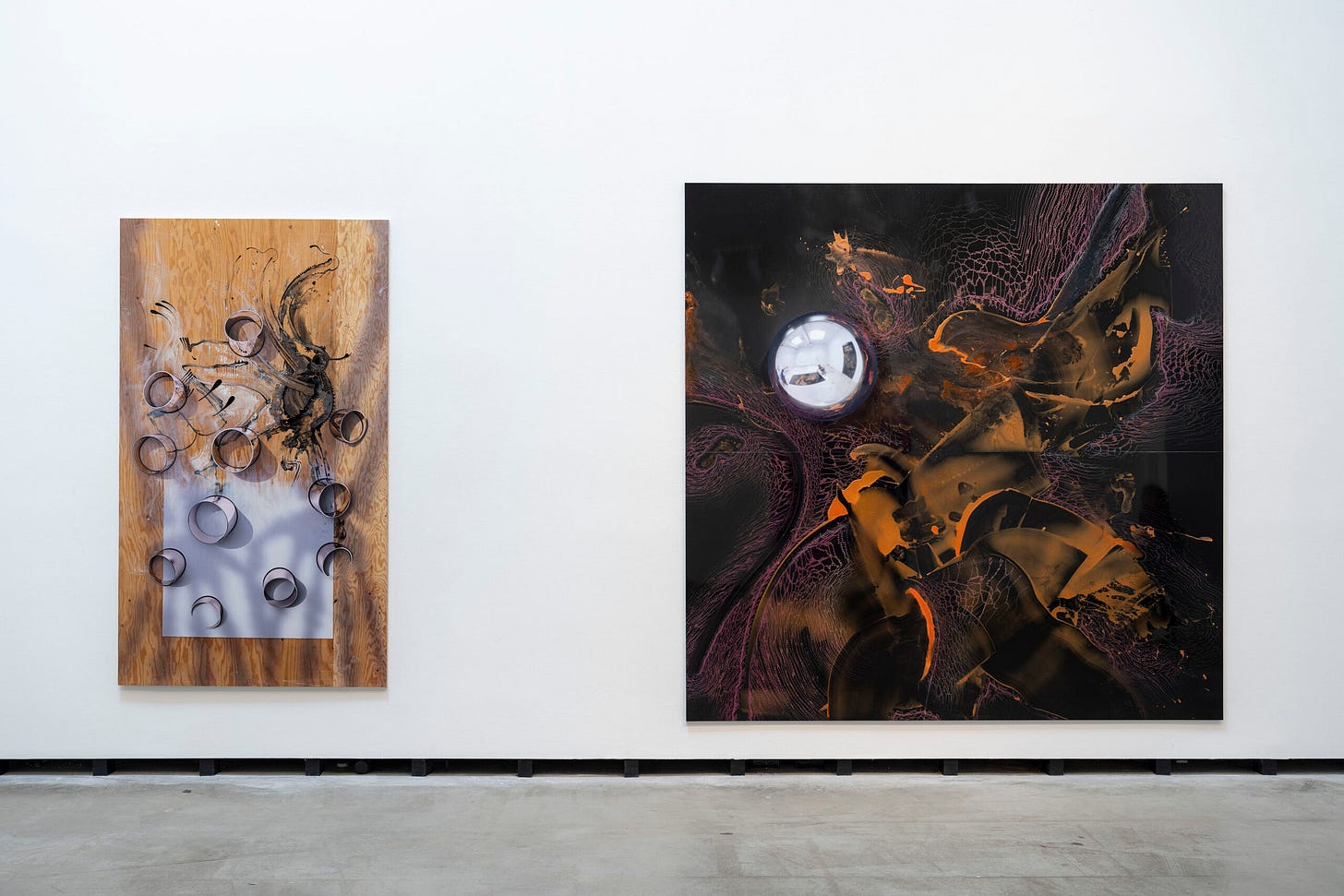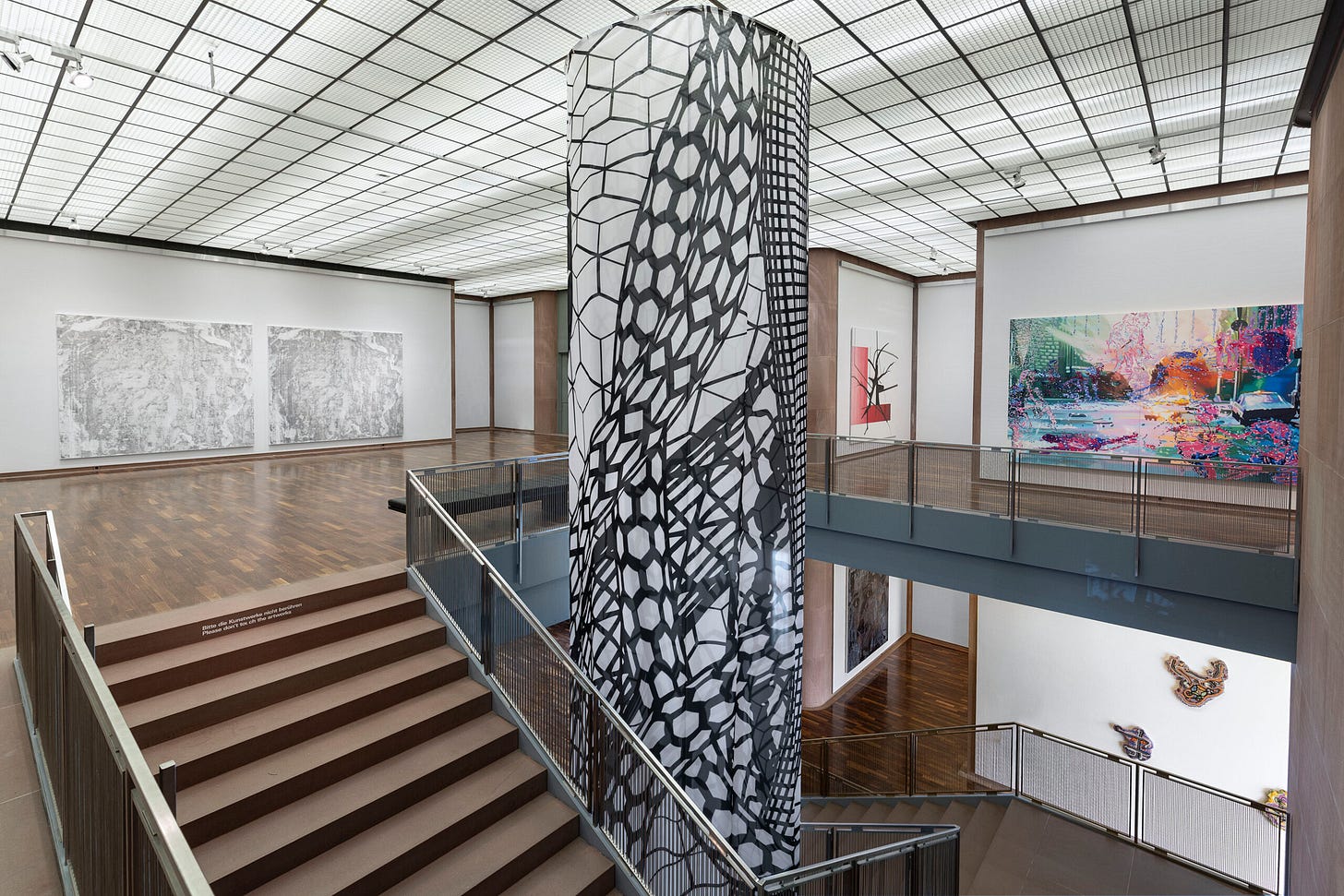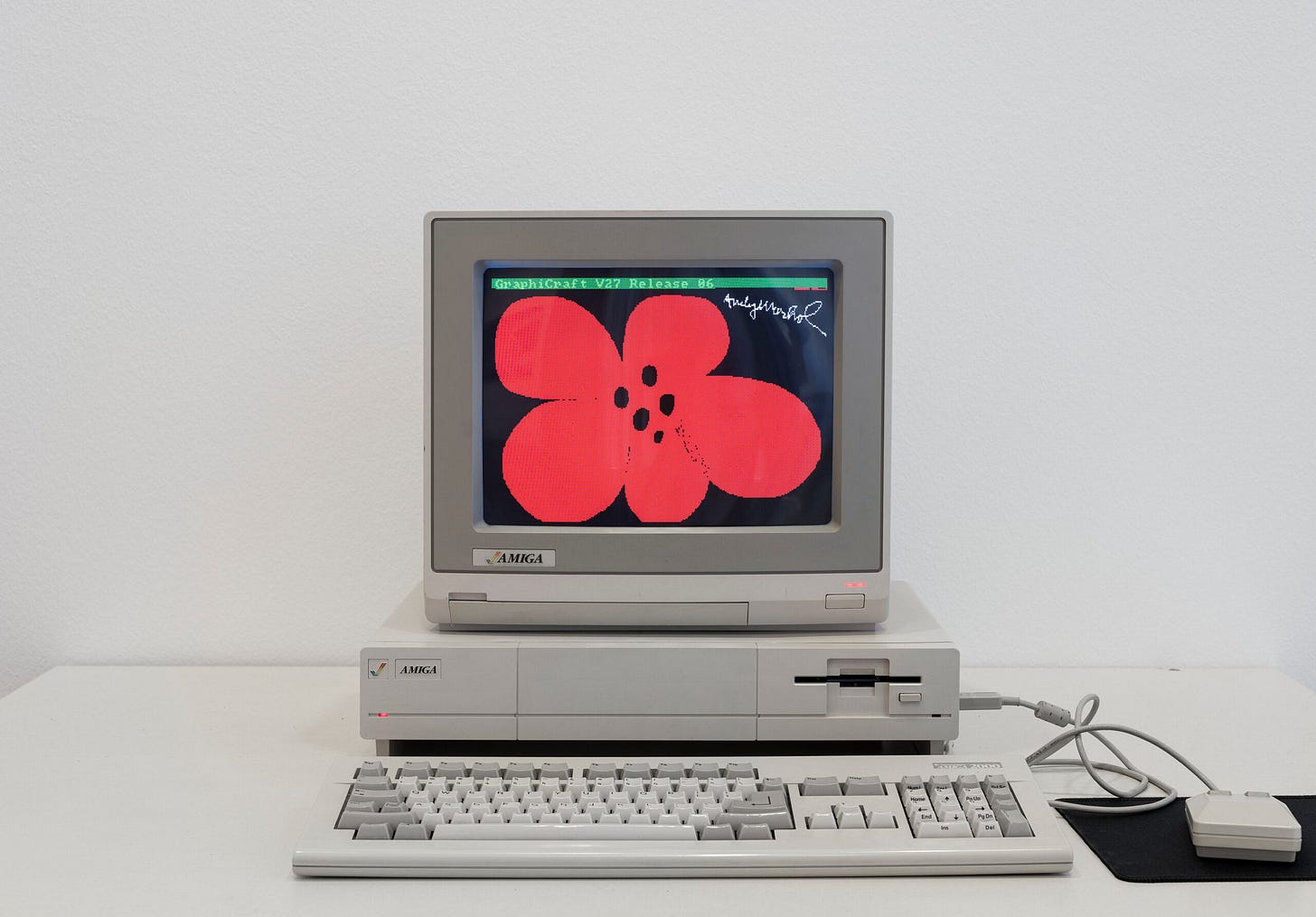An Unequal Fight: Hybrid Painting at Marta Herford & Kunsthalle Bielefeld
Two opposing media met in the artworks of a collaborative exhibition. A show that could have explored the radical changes in current art practice turned out...bland.
The least I can say about the joint exhibition at Marta Herford and Kunsthalle Bielefeld is that it left me with mixed feelings. The institutions collaborated on a show about how painting develops in the digital world and vice versa. A solid premise. You know what wasn’t solid? The execution.
I went into the show expecting a technical exploration of this media crossover. Unfortunately, only a fraction of the selected works offered an original perspective. At Marta Herford, Philipp Timischl (Millennial, Austrian) installed four paintings in a corner. A screen extends each work at the bottom. The works seemed to communicate with each other, the text displayed appeared like lines of a theatrical play enacted by the paintings. What a fun way of breaking the fourth wall. I was mesmerized by the concept, but my eyes were much longer on the screens than they were on the painted surfaces. Those appeared much less vibrant compared to the bright flickering screens underneath. It’s a phenomenon pretty much symbolic of the whole show: Are the works really hybrid, painting and the digital realm merging into each other, or aren’t those two competing media stuck on the same object together?

Dissolving the red thread
Some artists really got it right. An exhibition of this kind would have been unimaginable without Tishan Hsu’s (Baby Boomer, US-American) complex multimedia surfaces that imagine cyborg medicine and technoid human skin blending with silicone and digital distortion. Pieter Schoolwerth (Gen X, US-American) merges cursed versions of internet footage with paintings. Pasty textures meet glitchy digital figures, the analog paintings coming to life in a video work. I love the reference to The Sims aesthetics and its glitches. With Deep Fakes gone wrong and memefied pop culture references like a Drag-Shrek-Drake, Pieter captures exactly how dizzying the melting together of digital and analog feel.
I was also a huge fan of Seth Price’s (Gen X, US-American) hyperrealist references in painting. In his abstract painting, Thought Comes From the Body II (2022-23), he inserted a fish-eye view of him creating the very same work in the studio. We stan Jan Van Eyck (ca. 1390-1444, Flemish) references in this household. And in Ardomancer (2023), Seth added digitally generated metallic rings on actual paint on the wooden surface, the fake rings seemingly reflecting the real paint.

But the more I saw, the more I realized that the definitions of what’s digital and what’s painting in this exhibition are blurred, to put it benevolently. I’ll let the inclusion of Kerstin Brätsch (Gen X, German) slide, because even though her ceramic pieces are technically not painted, they look as if they were digitally painted like in those early 2000s Windows paint programs. But then, the curators started missing the mark more often. KAYA (a duo that Kerstin is part of) presented KAYA’s House (2015), an immersive play house with pictures, furniture, and music playing. Bodybags with Kerstin’s characteristic painterly patterns are attached to that house. And according to the work label, the colorful tiles inside are reminiscent of pixels… well, that’s what I’d call farfetched. Isn’t the point of hybridity that it mixes? It’s not enough to smack together paint and digitality like two LEGO stones… they don’t become one…they are still two different things…
Some works were fun in themselves, but didn’t feel relevant within the exhibition context. Take Avery Singer’s (Millennial, US-American) Karen (2024): An iconic Karen haircut overlaid with Ozempic shots and jizzy splashes of white paint. Periodt. I find her earlier work much better fitting within the exploration of digital aesthetics in painting. Yes, she still uses 3D rendering programs and computational aids to make the paintings, but that’s all in the background. Here, she just smacked two memes together and called it a day. To me, it’s just not enough to use digital tools to make the art. I want to see it in the artwork. It’s something I’ve talked about with Nikolas Müller (Millennial, German), many artists talk the talk but don’t walk the walk. Otherwise, how much involvement of digital tools is enough? Can I call my practice hybrid if I research motives on my iPad? Be serious…

Looking at the names that were disproportionally present throughout the exhibition, I suspect that the curators went through the exhibition catalog of Cecilia Alemani’s (Gen X, Italian) The Milk of Dreams (2022) Venice Biennale, closed their eyes, and randomly chose the artists on the first pages they opened. That’s probably how Amy Sillman (Baby Boomer, US-American) sneaked in. Like Babe: Is making an animation of your paintings really that groundbreaking?
In her Biennale, Cecilia included important artists who worked with the digital sphere, no doubt. Making this show here without Vera Molnar (1924-2023, French) who used computation as one of the first artists ever wouldn’t have made any sense. And Charlotte Johannesson (Silent Generation, Swedish) is also a pioneer of computation in the arts. But Charlotte’s angle is the connection of textile weaving with programming. There’s no painting, to be precise. But if your definition of painting is that it can be basically anything, then why even bother doing a survey exhibition on painting?

At Kunsthalle Bielefeld, I was particularly irritated at the display of a donated collection by Wulf Herzogenrath (Silent Generation, German). The curators argued that the exhibition was adding to the group show and its questions, mixing both throughout some rooms. It was not giving enriched discourse, it was rather giving “take your little brother with you when you go out with your friends.” Babes, just say that Wulf pressured you to show the collection during the highly frequented group show and that you couldn’t say no.
At this point, I find it disrespectful to not include Arno Beck (Millennial, German) in a show on hybrid painting. I also would have loved to see Hyperweirdkids (both Gen Z, German). Generally, why not include more artists? What are some 25 positions for a theme this complex and diverse? And if the topic of media hybridity is so relevant right now in 2024, how come the most representative works are the 1980s computer-made drawings by the dead Andy Warhol (1928-87, US-American)? That’s a bit embarrassing, lad.
The museums heavily bet on repetition. It makes sense to assume that most visitors won’t see both venues and therefore, some artists exhibit in both. But for God’s sake, I got how Jacqueline Humphries (Gen X, US-American) uses 3D printing on canvas after I saw the first work, why do you shove like seven more works down my throat?

And the Winner is…
Although the show wants to focus on how painting and the digital realm are intertwined through the overarching themes of Body, Space, Gesture, and Pattern, I’m left with the sensation that it’s not an equitable relationship. The exhibitions at both venues are focused on an offline experience. Virtual and Augmented Reality are limited to surfaces within the exhibition, they’re not how I get to experience the works. You either have to see it in the flesh or don’t bother at all, which is ironic for the media-hybrid premise.
In this tug-of-war, the analog wins. I was hoping to get some unhinged stuff that’d make me go “Well, that’s enough internet for today”. But painting kept the digital realm tame like a chihuahua in a handbag. The analog world still keeps the upper hand.
Between pixel and pigment. Hybrid painting in post-digital times, through November 10, 2024, at Marta Herford & Kunsthalle Bielefeld.
Marta Herford
Goebenstrasse 2–10
32052 Herford
Website
Instagram: @martaherford
Kunsthalle Bielefeld
Artur-Ladebeck-Strasse 5
33602 Bielefeld
Website
Instagram: @kunsthalle_bielefeld
I recommend seeing this show though. Let me know what you think in the comments. Also, don’t forget to share, it’s highly appreciated!
See you soon!!!
Jennifer
The Gen Z Art Critic




